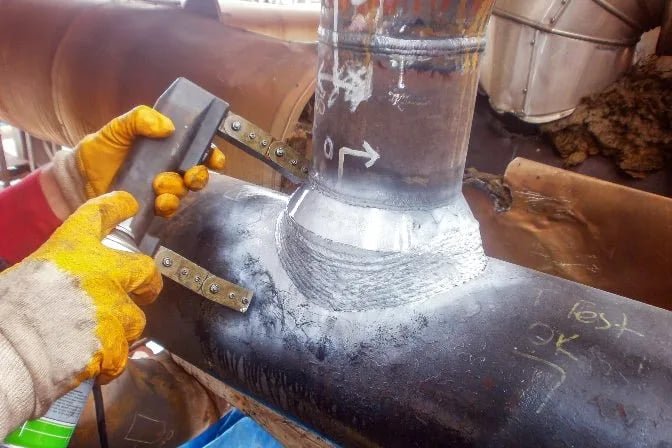Stay Code-Compliant: Professional Pipeline Welding Inspection Tailored to Your Demands
Stay Code-Compliant: Professional Pipeline Welding Inspection Tailored to Your Demands
Blog Article
Comprehensive Summary of Pipeline Welding Assessment Treatments
In the realm of pipeline construction, guaranteeing the honesty and safety of welded joints is paramount. Pipe welding examination procedures play a crucial duty in ensuring that welded links satisfy strict market standards and specifications. From thorough pre-welding assessments to detailed post-weld assessments, a distinct evaluation procedure is necessary for preserving the architectural soundness of pipelines. Comprehending the ins and outs of welding examination treatments is not only a regulative need however also a fundamental element of supporting the dependability of these vital infrastructures.
Pre-welding Inspection Preparations
Prior to commencing the welding procedure, complete pre-welding evaluation prep work are necessary to ensure the stability and quality of the weld joint. These prep work entail a precise exam of the materials to be bonded, the welding equipment, and the job setting. The materials have to be examined for any type of defects, pollutants, or incongruities that could jeopardize the weld. This consists of monitoring for proper product qualities, dimensions, and surface area conditions. Pipeline Welding Inspection. Additionally, the welding tools requires to be checked to verify that it remains in great functioning condition, adjusted appropriately, and suitable for the particular welding procedure. Any kind of issues with the equipment ought to be attended to promptly to avoid flaws in the weld. Last but not least, the workplace should be examined for sanitation, correct air flow, and precaution to ensure a conducive setting for the welding operation. By carrying out extensive pre-welding examination prep work, possible problems can be determined and fixed at an early stage, resulting in premium and trustworthy weld joints.
Welding Procedure Credentials
Extensive pre-welding inspection preparations lay the foundation for the vital process of Welding Treatment Certification, making sure the integrity and high quality of the weld joint. Welding Treatment Certification (WPQ) is an essential action in the welding procedure that includes screening and certifying welding treatments to ensure they satisfy details criteria and demands. The WPQ process usually consists of welding procedure requirements growth, welding treatment certification testing, and paperwork of the results.
Throughout welding treatment spec advancement, crucial details such as the welding process, welding materials, joint style, and welding parameters are defined to produce a detailed treatment. Ultimately, welding procedure credentials screening is performed to validate the proposed procedure's honesty. This screening commonly includes welding examination promo codes that undergo various mechanical and non-destructive examinations to assess the weld's quality and adherence to the defined criteria.
In-process Weld Assessment
Throughout the welding process, in-process weld evaluation plays a crucial function in guaranteeing the quality and honesty of the weld joint - Pipeline Welding Inspection. This type of assessment entails checking the welding parameters, examining the weld bead formation, and detecting any kind of prospective problems or interruptions as they happen. By performing in-process weld inspections, welding operators can immediately attend to any type of issues that may develop, consequently guaranteeing and avoiding additional defects that the final weld fulfills the required specifications
Usual techniques made use of for in-process weld evaluation consist of aesthetic examination, liquid penetrant testing, magnetic particle screening, ultrasonic testing, and radiographic screening. Generally, in-process weld examination is crucial for maintaining the quality and integrity of welded pipelines.
Non-destructive Testing (NDT)
Non-destructive Screening (NDT) is an best site essential approach employed in pipe welding examination to analyze the stability of weld joints without triggering damage to the bonded framework. By making use of different NDT techniques, examiners can assess the top quality of welds and identify any type of flaws or stoppages that may compromise the architectural sturdiness of the pipeline. Common NDT methods image source made use of in pipeline welding inspection include Radiographic Screening (RT), Ultrasonic Testing (UT), Magnetic Particle Evaluating (MPT), Fluid Penetrant Testing (LPT), and Visual Screening (VT)
RT entails the usage of X-rays or gamma rays to produce pictures of the interior structure of the weld, allowing inspectors to discover defects such as porosity, splits, or incomplete combination. UT makes use of high-frequency sound waves to discover defects below the surface of the weld, providing thorough information concerning the dimension and area of issues. MPT and LPT are used to identify surface-breaking defects by applying penetrant liquids or magnetic fragments to the weld area. Furthermore, VT entails visual inspection of welds to determine any kind of visible flaws.
Post-weld Inspection and Documents


Documentation of post-weld assessment searchings for is necessary for preserving quality assurance documents and guaranteeing conformity with sector criteria and regulations. Detailed records ought to include information regarding the assessment methods utilized, the area and nature of any type of issues located, and any kind of corrective actions taken - Pipeline Welding Inspection. Appropriate paperwork not just offers as a record of the weld's high quality however additionally aids in future upkeep and inspection processes
Verdict

In verdict, pipe welding inspection treatments play a vital function in ensuring the high quality and stability of welds. In general, adherence to proper evaluation methods is essential to the success of pipe welding projects.
From precise pre-welding inspections to extensive post-weld evaluations, a distinct assessment procedure is necessary for maintaining the structural stability of pipelines. By conducting in-process weld inspections, welding operators can quickly address any type of problems that may develop, thus stopping additional problems and making sure that the last weld meets the needed requirements.
Typical approaches used for in-process weld assessment include visual inspection, liquid penetrant screening, magnetic bit screening, ultrasonic screening, and a knockout post radiographic screening.Non-destructive Screening (NDT) is a crucial technique utilized in pipe welding examination to examine the stability of weld joints without causing damages to the welded framework. Post-weld inspection includes various techniques to assess the welds for flaws, consisting of aesthetic assessment, color penetrant testing, magnetic bit testing, ultrasonic testing, and radiographic screening.
Report this page